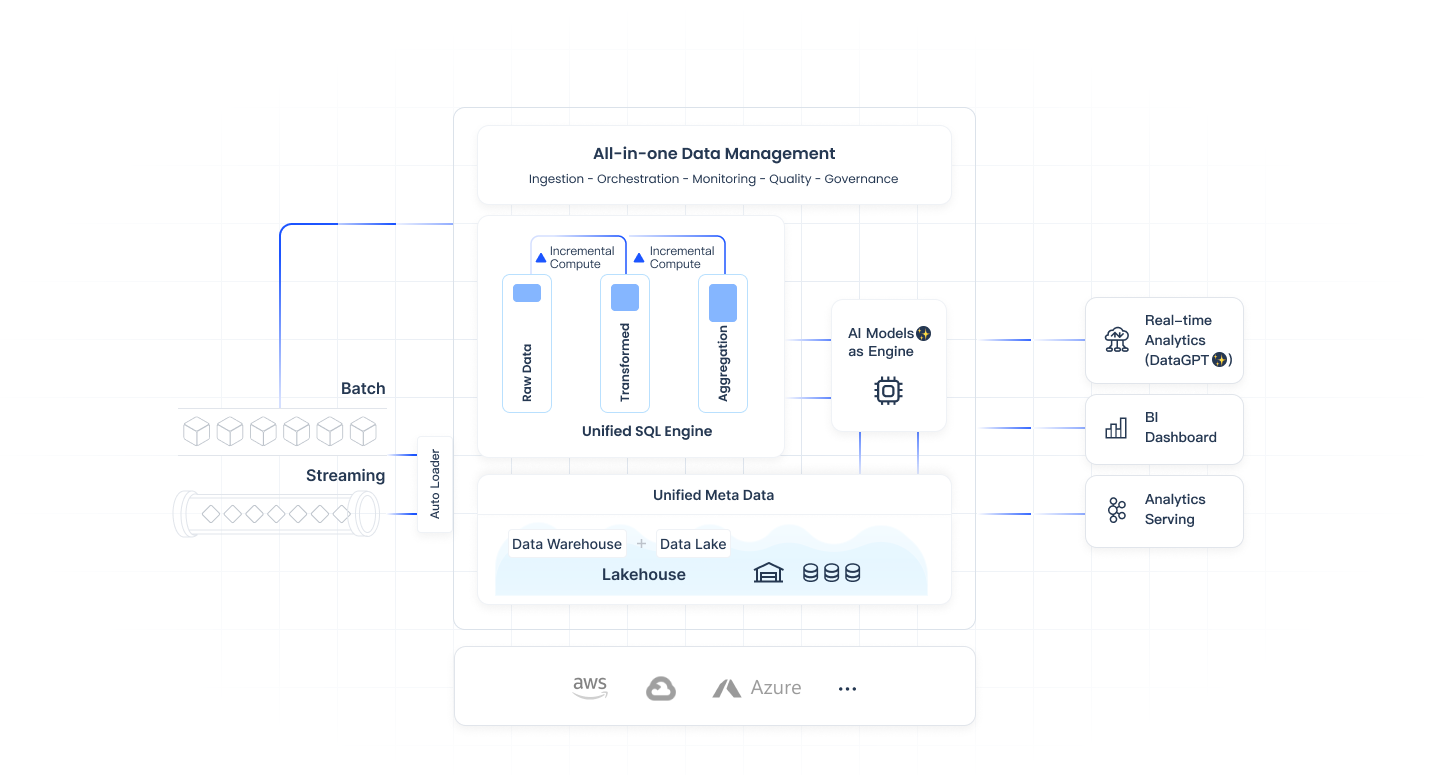Understanding the Importance of Lakehouse in Today's Data Landscape

A Lakehouse represents a modern data architecture that combines the best features of data lakes and data warehouses. Effective data management has become crucial in today's business environment. Organizations generate massive amounts of data daily, with estimates showing 2.5 quintillion bytes produced each day. Efficient data architectures are essential to handle this exponential growth. Modern data architectures help organizations make better use of their data, improve decision-making, and drive business growth. The growing need for scalable and flexible data solutions highlights the importance of adopting innovative approaches like the Lakehouse.
What is a Lakehouse?
Definition and Core Principles
A Lakehouse represents a modern data architecture that merges the capabilities of data lakes and data warehouses. Data lakes store raw, unprocessed data, while data warehouses handle structured, processed data. The Lakehouse combines these functionalities to offer a unified platform.
Combining Data Lakes and Data Warehouses
Data lakes emerged with the onset of Big Data to store vast amounts of raw data. Data warehouses provided structured storage for processed data. Historically, organizations implemented these systems separately to avoid overloading resources. The Lakehouse integrates both systems, eliminating the need for separate architectures. This integration allows seamless data management and processing.
Key Features of a Lakehouse
Key features of a Lakehouse include:
Unified Storage: Combines the storage capabilities of data lakes and data warehouses.
Real-time Analytics: Supports real-time data processing and analytics.
Scalability: Handles large volumes of data efficiently.
Cost Efficiency: Reduces storage costs and optimizes resource utilization.
Enhanced Data Quality: Ensures high data quality and governance.
Evolution of Data Architectures
Data architectures have evolved significantly over time. Traditional data warehouses and the emergence of data lakes paved the way for the Lakehouse.
Traditional Data Warehouses
Traditional data warehouses stored structured data for business intelligence and reporting. These systems required significant resources for data processing and storage. Data warehouses provided high performance but lacked flexibility in handling diverse data types.
Emergence of Data Lakes
With the rise of Big Data, data lakes emerged to store raw, unprocessed data. Data lakes offered flexibility in handling various data formats. However, managing data lakes posed challenges in ensuring data quality and governance. Organizations often faced difficulties in extracting meaningful insights from raw data.
The Need for a Unified Architecture
The need for a unified architecture became evident as organizations struggled with separate data lakes and data warehouses. A unified architecture like the Lakehouse addresses these challenges. The Lakehouse offers a single platform for storing, processing, and analyzing data. This approach enhances data accessibility, quality, and governance.
Benefits of a Lakehouse

Scalability and Flexibility
Handling Large Volumes of Data
A Lakehouse architecture can handle vast amounts of data efficiently. Traditional data warehouses often struggle with scalability issues. Data lakes offer flexibility but lack the performance needed for real-time analytics. A Lakehouse combines the best features of both, providing an architecture that scales effortlessly. Organizations can store structured and unstructured data in one location without compromising performance.
Adapting to Changing Business Needs
Businesses today face rapidly changing environments. A Lakehouse adapts to these changes by offering a flexible data platform. Traditional data architectures often require significant time and resources to adapt. A Lakehouse simplifies this process. The unified platform allows organizations to quickly adjust their data strategies. This adaptability ensures that businesses remain competitive.
Cost Efficiency
Reducing Storage Costs
A Lakehouse reduces storage costs by combining the storage capabilities of data lakes and data warehouses. Traditional data warehouses require expensive hardware and maintenance. Data lakes offer cost-effective storage but lack the performance needed for analytics. A Lakehouse provides a balanced approach. Organizations can store large volumes of data at a lower cost while maintaining high performance.
Optimizing Resource Utilization
Resource utilization becomes more efficient with a Lakehouse. Traditional data architectures often require separate systems for storage and processing. This separation leads to resource duplication and inefficiencies. A Lakehouse integrates these systems into a single platform. This integration optimizes resource use, reducing operational costs. Organizations can allocate resources more effectively, leading to better overall performance.
Enhanced Data Analytics
Real-time Data Processing
Real-time data processing becomes possible with a Lakehouse. Traditional data warehouses often struggle with real-time analytics due to their rigid structure. Data lakes offer flexibility but lack the necessary performance. A Lakehouse bridges this gap. The architecture supports real-time data processing, enabling organizations to make quicker decisions. This capability enhances business agility and responsiveness.
Improved Data Quality and Governance
Data quality and governance improve significantly with a Lakehouse. Traditional data lakes often face challenges in maintaining data quality. Data warehouses provide better governance but lack flexibility. A Lakehouse offers a unified platform that ensures high data quality and robust governance. Organizations can manage their data more effectively, ensuring compliance and accuracy.
Implementing a Lakehouse
Key Considerations
Choosing the Right Technology
Selecting the appropriate technology forms the foundation of a successful Lakehouse implementation. Organizations should evaluate their data needs and existing infrastructure. Singdata Lakehouse offers a unified platform that merges data lakes and data warehouses. This integration ensures seamless data management and processing. The platform's cloud-agnostic flexibility allows data access across multiple cloud environments. This feature provides scalability and adaptability for changing business requirements.
Data Integration Strategies
Effective data integration strategies are crucial for a Lakehouse. Organizations must ensure that structured and unstructured data can coexist harmoniously. Singdata Lakehouse supports various data formats, enabling smooth integration. Real-time analytics capabilities allow immediate data processing and insights. This feature enhances decision-making and operational efficiency. A unified catalog within the platform simplifies data management and access.
Best Practices
Ensuring Data Security
Data security remains paramount in any data architecture. Implementing robust security measures protects sensitive information. Singdata Lakehouse provides advanced security features to safeguard data. Encryption protocols ensure data protection during storage and transmission. Access controls restrict unauthorized access, maintaining data integrity. Regular security audits help identify and mitigate potential vulnerabilities.
Maintaining Data Quality
Maintaining high data quality is essential for accurate analytics. Singdata Lakehouse offers tools to ensure data consistency and reliability. Automated data validation checks detect and correct errors. The platform's governance features enforce data quality standards. Real-time data processing capabilities enhance data freshness and relevance. These practices ensure that organizations derive meaningful insights from their data.
Lakehouse architecture plays a crucial role in modern data management. The unified platform combines the best features of data lakes and data warehouses, offering scalability, cost efficiency, and enhanced data quality. Practical applications span various industries, from financial services to healthcare and retail. Organizations can benefit from real-time analytics, improved governance, and reduced data redundancy. Adopting a Lakehouse architecture can revolutionize data strategies, making it a valuable consideration for businesses aiming to optimize their data infrastructure.
See Also
Deciphering Cloud-Based Data Structure
The Significance of Modern Big Data Solutions
Exploring Components of Big Data Frameworks
